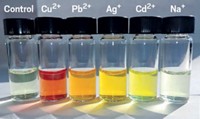Advertisement
Grab your lab coat. Let's get started
Welcome!
Welcome!
Create an account below to get 6 C&EN articles per month, receive newsletters and more - all free.
It seems this is your first time logging in online. Please enter the following information to continue.
As an ACS member you automatically get access to this site. All we need is few more details to create your reading experience.
Not you? Sign in with a different account.
Not you? Sign in with a different account.
ERROR 1
ERROR 1
ERROR 2
ERROR 2
ERROR 2
ERROR 2
ERROR 2
Password and Confirm password must match.
If you have an ACS member number, please enter it here so we can link this account to your membership. (optional)
ERROR 2
ACS values your privacy. By submitting your information, you are gaining access to C&EN and subscribing to our weekly newsletter. We use the information you provide to make your reading experience better, and we will never sell your data to third party members.
Environment
Not So Dye-Fast
Sustainability: Polymer additives aid removal of loose dye molecules, significantly reducing water and energy use in coloring textiles
by Stephen K. Ritter
March 23, 2015
| A version of this story appeared in
Volume 93, Issue 12
Many of the colorful textile products we use—think clothing, sofas, and carpeting—come courtesy of reactive dye molecules that are designed to adsorb onto and covalently bond to fabric fibers. But during a typical dyeing treatment, up to 40% of the dye molecules hydrolyze and remain only loosely associated with the fibers via electrostatic interactions such as hydrogen bonding. Manufacturers must repeatedly wash and rinse the fabric to get the unsecured dye out, which requires a lot of water, time, and energy. Motivated to make the dye wash-off process more efficient, Richard S. Blackburn of the University of Leeds, in England, introduced vinylpyridine-based polymers into the process to electrostatically attract and shepherd away errant dye (ACS Sustainable Chem. Eng. 2015, DOI: 10.1021/acssuschemeng.5b00034). These polymers, such as poly(vinylpyridine-N-oxide), are already used as additives in laundry detergent to maintain colorfastness. Blackburn and research assistant Nabeel Amin found that using the polymers during dyeing cuts water use in half, reduces processing time by 75%, and consumes 90% less energy.





Join the conversation
Contact the reporter
Submit a Letter to the Editor for publication
Engage with us on Twitter